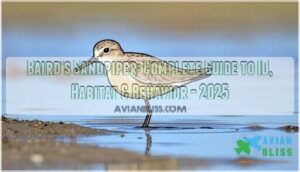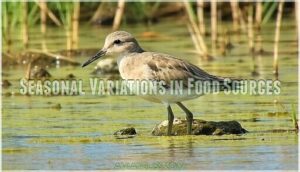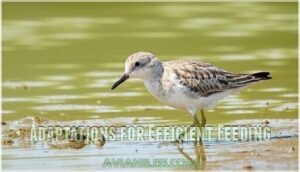This site is supported by our readers. We may earn a commission, at no cost to you, if you purchase through links.

This marathon migrant sports elongated wings perfect for its epic journeys from Arctic tundra to South American wintering grounds.
Watch for its preference to forage alone at flock edges, choosing drier spots over crowded mudflats.
Its straight, slender bill and scaly buff-brown plumage create perfect tundra camouflage.
Listen for its sharp "preep" call—like a police whistle cutting through wetland chatter.
These solitary souls avoid the chaos other sandpipers seem to love, making identification easier once you know their quirks.
Table Of Contents
- Key Takeaways
- Identifying Baird’s Sandpiper
- Habitat and Global Distribution
- Feeding Habits and Foraging Behavior
- Breeding Biology and Reproductive Cycle
- Conservation Status and Threats
- Frequently Asked Questions (FAQs)
- What is the difference between a Baird’s and a Western sandpiper?
- How big are bairds sandpipers?
- What color are Baird’s sandpiper legs?
- How did Bairds Sandpiper get its name?
- What are some common nicknames for Bairds Sandpiper?
- How fast can a Bairds Sandpiper fly?
- Do Bairds Sandpipers form mixed flocks with other species?
- What is the average lifespan of a Bairds Sandpiper?
- How long do Bairds Sandpipers live?
- What predators threaten Bairds Sandpipers most?
- Conclusion
Key Takeaways
- You’ll identify them by their black legs and elongated wings – These features distinguish Baird’s sandpipers from similar species, like Least Sandpipers, which have yellow legs.
- They prefer solitary foraging at flock edges – Unlike other sandpipers that crowd together, you’ll find them feeding alone in drier areas away from mudflats.
- Listen for their sharp "preep" call – This police whistle-like sound cuts through wetland noise and helps confirm identification.
- They’re marathon migrants covering 15,000 kilometers – You’ll encounter them during peak migration in late April and early September as they travel from Arctic breeding grounds to South America.
Identifying Baird’s Sandpiper
Spotting a Baird’s Sandpiper requires knowing its key field marks: long wings that extend past the tail, a buff-washed breast with fine streaking, and a preference for drier edges of wetlands.
You’ll distinguish this elegant "peep" from similar species by its scaly-backed appearance, black legs, and tendency to forage away from water’s edge where other sandpipers crowd, which is a key aspect of its forage behavior.
Distinctive Physical Features
Every Baird’s sandpiper possesses unmistakable traits that set it apart from other shorebird species.
When identifying this small wader, you’ll notice its exceptionally long wings extending well past the tail tip—a dead giveaway among sandpiper identification features.
Key physical markers include:
- Wing Structure: Elongated, tapering wings built for marathon migrations
- Beak Shape: Straight, slender black bill without drooping tip
- Leg Color: Distinctive black legs lacking webbing between toes
- Plumage Texture: Soft, scaled feather patterns with buff-brown tones creating elegant sandpiper habitat camouflage
Plumage Variations Across Seasons
Baird’s sandpiper molt patterns create distinct seasonal looks that help with sandpiper identification.
During breeding season, you’ll notice rich buff tones across the breast and head, giving this shorebird species warm golden hues.
The feather color shifts to grayer tones in winter, while plumage texture remains consistently scaly across the back.
Wing bars stay subtle year-round, and seasonal camouflage helps birds blend into tundra during nesting periods.
Comparison With Similar Sandpiper Species
When comparing Baird’s Sandpiper to similar species, focus on key differences that’ll save you headaches in the field.
White-rumped Sandpiper shows that telltale white rump patch—once you spot it, case closed.
Pectoral Sandpiper appears bulkier with distinct chest streaking, while Least Sandpiper sports yellow legs versus Baird’s black ones.
Size variations matter too: Baird’s longer body and extended wingtips create a sleeker profile than chunkier Western Sandpipers during sandpiper migration periods.
Understanding the bird migration patterns is essential for accurate identification of Baird’s Sandpiper in different habitats.
Unique Behavioral Traits for Identification
You’ll spot this arctic breeder by its solitary nature and unique foraging tactics.
Unlike other sandpipers that huddle together, bairds sandpiper prefers the edges of flocks, often feeding alone in drier areas.
During sandpiper migration, watch for birds that avoid crowded mudflats, instead choosing vegetated spots near puddles.
This shorebird conservation priority shows distinct flocking patterns, staying independent while others cluster tightly together, making it a key subject for shorebird conservation.
Vocalizations and Calls
Can you tell me the Baird’s Sandpiper vocalization patterns? Their contact call is a distinctive "preep" with a police whistle-like quality, while males perform complex songs during breeding displays that include purring trills, rising "twoowee" calls, and chattering sounds, often mixing guttural trills with buzzy notes.
Here’s your distinct audio signals that help identify this arctic breeder:
- Contact calls: A sharp, trilled "preep" or "kriiip" sound with police whistle quality – higher than Pectoral Sandpiper calls
- Flight calls: Soft rolling "kirrp" notes during takeoff and landing, helping distinguish sandpiper behavior patterns
- Breeding song: Complex vocal traits featuring liquid trills mixed with rising buzzy notes that support shorebird conservation efforts through species recognition
Habitat and Global Distribution
Baird’s Sandpiper travels one of the most remarkable journeys in the bird world, covering up to 15,000 kilometers between Arctic breeding grounds and South American wintering sites.
From Arctic tundra to South American grasslands, these marathon migrants redefine the meaning of wanderlust
You’ll find this long-distance champion using surprisingly diverse habitats along the way, from dry tundra ridges to muddy farm fields, making it a unique species in terms of its migration patterns and diverse habitats.
Breeding Grounds in Arctic Tundra
You’ll find these long distance migrant sandpipers in the most remote corners of Alaska and northern Canada, where arctic wildlife thrives.
Their tundra habitat spans dry ridges and gravel areas above the treeline.
These hardy birds choose elevated nesting sites away from wet marshes, preferring windswept slopes that offer protection from predators.
Bird conservation efforts monitor these critical breeding grounds closely, as climate change threatens traditional arctic nesting locations across their range, impacting their traditional nesting locations.
Migration Routes Through Great Plains
You’ll find Baird’s Sandpipers following the Central Flyway through America’s heartland during their epic journeys.
These long distance migrants prefer the Great Plains’ agricultural fields, mudflats, and shallow wetlands as essential stopover sites.
Their migratory patterns peak in late April and early September, with flocks gathering at strategic locations to refuel before continuing their remarkable transcontinental adventure.
Wintering Areas in South America
Every winter, thousands of these hardy migratory patterns travelers set out on an epic journey to South America Habitat locations spanning from Ecuador to Argentina’s southern tip.
These wetland bird champions choose some pretty specific real estate for their extended vacation:
- High-altitude Andean salt flats and puna grasslands between 3,000-4,000 meters
- Patagonian freshwater marshes and open grasslands
- Interior highland lakes and flooded meadows across the continent.
Unlike their coastal cousins, Baird’s Sandpipers prefer inland sanctuaries over oceanic shores during Wintering Patterns season.
The birds’ distinctive plumage characteristics play a vital role in identifying them in their various habitats.
Preferred Stopover Sites During Migration
You’ll find Baird’s Sandpipers refueling at strategic stopover sites during their epic 15,000-kilometer journey.
The Great Plains serve as their primary pit stop, where massive flocks gather in shallow wetlands and mudflats.
These wetland birds prefer drier edges of ponds and temporary pools over deep water.
Wildlife refuges across the central flyway provide critical habitat, supporting their remarkable refueling strategies before continuing south.
The success of their migration relies on accessing quality migratory bird stopovers that offer necessary resources for recovery and completing their journey to the desired destination.
Adaptations to Diverse Habitats
Adapting like a chameleon across environments, you’ll notice Baird’s Sandpipers display remarkable Habitat Flexibility during bird migration routes.
Their Feather Adaptations provide insulation for Arctic breeding and streamlined flight efficiency.
These avian species make essential Behavioral Adjustments, switching from wet mudflats to dry agricultural fields seamlessly.
Their unique Ecological Niche allows successful bird watching opportunities at wildlife refuge locations, demonstrating how sandpiper nesting strategies complement their diverse Migration Patterns.
Feeding Habits and Foraging Behavior
You’ll discover that Baird’s Sandpiper has quite particular tastes in regard to mealtime – they’re the picky eaters of the shorebird world who prefer dining on dry land rather than getting their feet wet.
These clever birds have mastered a unique foraging style that sets them apart from their mudflat-loving cousins, making them fascinating to observe during migration.
Diet Composition and Preferences
You’ll discover Baird’s Sandpiper’s diet centers on invertebrates, making up over 80% of their nutritional intake during breeding season.
Their food sources shift seasonally, adapting to available resources along bird migration routes.
Key dietary preferences include:
- Chironomid midges – comprising 60% of prey at freshwater stops
- Small insects – larvae and adults under 10mm preferred
- Plant seeds – up to 35% during spring migration
These feeding habits support their remarkable sandpiper nesting success across diverse habitats.
Understanding the essential sandpiper food sources is vital for their survival and migration patterns.
Foraging Techniques and Behaviors
You’ll spot Baird’s Sandpipers using their signature "pick and probe" technique across drier mudflat edges.
They methodically walk forward while rapidly pecking at surface invertebrates, unlike other shorebirds that wade deeper.
Their foraging strategies include quick directional changes and brief pauses to scan for prey.
These feeding habits support their demanding migration patterns through efficient energy acquisition.
Understanding the vital bird feeder systems is essential for creating an environment that fosters their natural behaviors.
Seasonal Variations in Food Sources
Throughout their remarkable journey, Baird’s Sandpipers adjust their nutrition and diet to match Food Availability across different seasons.
Baird’s Sandpipers become living chameleons, switching from protein-packed Arctic feasts to energy-dense seeds as they chase seasons across continents.
Their healthy lifestyle depends on Seasonal Foraging strategies that shift dramatically from Arctic Feeding on protein-rich invertebrates to Winter Nutrition focused on seeds and plant matter during Migration Diet phases.
Here’s how their seasonal menu changes:
- Spring Arctic rush – They gorge on emerging midges and mosquito larvae, fueling their metabolism for breeding season energy demands
- Summer protein feast – Adults focus on chironomid larvae and spiders while feeding chicks, maintaining peak exercise and fitness levels
- Fall migration prep – They switch to energy-dense seeds and small crustaceans, building fat reserves for their epic 15,000-kilometer journey south
Adaptations for Efficient Feeding
Beyond its slender, slightly drooped beak structure, you’ll notice how efficiently this bird maximizes every feeding opportunity.
Its streamlined bill penetrates soft substrates with precision, while rapid feeding speed helps capitalize on fleeting food sources.
The bird’s enhanced digestion efficiency processes invertebrates quickly, supporting its demanding metabolism during long migrations.
These foraging tactics guarantee the best nutrition for survival.
The bird’s ability to adapt to different environments relies on effective bird adaptations that enhance its overall survival chances.
Impact of Diet on Migration Patterns
Baird’s Sandpipers must strategically time their epic 15,000-kilometer journeys around Food Sources availability.
Their high-energy diet of invertebrates fuels these marathon flights, while specialized metabolism helps them build essential Energy Reserves at key Stopover Strategies locations.
Smart Migration Routes follow productive wetlands where their nutrition needs align with peak insect abundance, making dietary timing everything for survival.
Breeding Biology and Reproductive Cycle
You’ll witness Baird’s Sandpiper’s remarkable breeding cycle unfold across the harsh Arctic tundra, where timing is everything for successful reproduction.
These determined birds must complete their entire breeding process within the brief Arctic summer, making every day count from courtship to fledging.
Courtship Displays and Pair Formation
During Arctic breeding season, male Baird’s Sandpipers perform elaborate aerial displays to attract females.
You’ll witness males soaring high above tundra, then diving while producing distinctive trilling calls.
Their courtship behavior includes ground displays where males puff feathers and circle potential mates.
Pair bonding occurs through these mating rituals, with successful mate selection leading to monogamous partnerships throughout the breeding season.
Nest Construction and Site Selection
Once pairs form, you’ll find these sandpipers selecting nesting sites with remarkable precision.
They choose elevated, well-drained locations that offer safety and camouflage for their precious clutch.
Site Selection criteria include:
- Dry tundra ridges above wet lowlands
- Gravel patches with sparse vegetation cover
- Areas near water sources but not waterlogged
- Locations with natural windbreaks like rocks or shrubs
- Sites offering clear sightlines for predator detection
The nest itself is surprisingly simple—just a shallow scrape lined with available materials like lichen, grasses, and Arctic moss.
Understanding sandpiper nesting habits is vital for conservation efforts.
Egg-laying and Incubation Period
After mating, you’ll find female Baird’s Sandpipers typically lay four olive-buff eggs with dark spotting in late May or early June.
The incubation period lasts exactly 20-21 days, with both parents taking turns warming the eggs in their simple ground scrape nest lined with lichens and grasses throughout the brief Arctic summer.
Parental Care and Chick Development
Once eggs hatch, you’ll witness both parents sharing chick-rearing duties with remarkable dedication.
The downy youngsters can walk and feed themselves within hours, though they stay close to their guardians for warmth and protection.
This parental investment includes brooding during harsh Arctic weather and guiding fledglings to prime feeding spots.
Their brood survival depends heavily on this attentive care during those critical first weeks, and understanding the importance of bluebird parental care is vital for appreciating the nuances of bird development.
Breeding Success Rates and Factors
Understanding what drives successful breeding helps you appreciate why some Baird’s Sandpiper pairs thrive while others struggle. Nest Survival averages 52-72% depending on breeding habitat quality, with experienced pairs showing better Mate Selection and site fidelity.
- Egg Viability reaches 82-89% in ideal Arctic conditions with abundant food resources
- Chick Mortality drops substantially when parents synchronize nesting with peak insect biomass
Predation accounts for 28-48% of breeding failures, primarily from Arctic foxes and jaegers
Conservation Status and Threats
While Baird’s Sandpiper maintains a stable global population of over 300,000 individuals, you’ll find this remarkable migrant faces mounting pressures from habitat destruction and climate shifts.
The species depends on an intricate network of stopover sites and Arctic breeding grounds that are increasingly threatened by human development and warming temperatures, which poses a significant threat to its survival due to climate shifts.
Current Population Trends and Estimates
Knowing how these Arctic specialists are doing helps gauge conservation priorities.
You’ll find current population trends remain relatively stable, with global estimates hovering between 300,000-500,000 individuals.
Trend analysis relies on standardized estimate methods through breeding surveys and migration counts.
| Population Metric | Current Estimate | Trend Status |
|---|---|---|
| Global Population | 300,000-500,000 | Stable |
| Breeding Range | Arctic tundra | Unchanged |
| Annual Fluctuation | Within 10% | Normal variation |
| IUCN Classification | Least Concern | No change |
| Monitoring Coverage | International | Ongoing |
Species monitoring programs show conservation impact through collaborative tracking efforts that maintain this sandpiper’s secure status across its vast range.
Habitat Loss and Degradation Impacts
Several major threats put Baird’s Sandpipers at risk during their epic migrations.
Wetland Destruction eliminates essential stopover sites you’d expect them to use for refueling. Habitat Fragmentation breaks up their travel corridors, forcing longer flights that drain energy reserves.
Agricultural conversion destroys grassland feeding areas, while Ecosystem Disruption from development alters food webs.
Soil Erosion reduces invertebrate populations they depend on, contributing to Biodiversity Loss across their range.
Climate Change Effects on Breeding Grounds
Arctic warming creates serious challenges for Baird’s Sandpipers on their breeding grounds.
Rising temperatures force habitat shifts as suitable breeding areas shrink by half.
Earlier snowmelt disrupts breeding timing, causing mismatches with insect availability.
These birds can currently adjust migration patterns, but flexibility has limits, and climate change affects their reproductive health, threatening population stability across traditional nesting sites.
Conservation Efforts and Protected Areas
Rising temperatures and changing precipitation patterns threaten Arctic breeding habitats, but you’ll find hope through dedicated conservation efforts.
Protected areas and wildlife refuges now safeguard critical stopover sites along migration routes, while conservation policies promote habitat preservation across international borders.
Understanding the current bird conservation status is essential for developing effective protection strategies.
- Arctic National Wildlife Refuge – Protects vast breeding territories in Alaska’s tundra regions
- Great Plains Conservation Initiative – Secures grassland stopover habitats through ecological restoration programs
- International Migratory Bird Treaties – Coordinates conservation efforts across North and South American flyways
Research Initiatives and Monitoring Programs
Dedicated wildlife researchers use cutting-edge GPS transmitters and geolocators for Species Tracking Baird’s Sandpipers across their 15,000-kilometer journey.
Data Analysis from these monitoring programs reveals critical stopover sites you’d never expect.
Habitat Monitoring initiatives track wetland changes affecting migration routes.
Population Studies combine citizen science with professional research, creating a thorough picture, which contributes to Conservation Efforts.
These Conservation Efforts help protect tomorrow’s sandpiper generations.
Frequently Asked Questions (FAQs)
What is the difference between a Baird’s and a Western sandpiper?
Baird’s sandpipers migrate up to 15,000 km annually.
You’ll spot key differences easily: Baird’s has black legs and a straight bill, while Western sandpipers sport webbed feet and a drooped bill tip with rusty-red breeding plumage.
How big are bairds sandpipers?
You’ll find these small shorebirds measuring 5-1 inches long with impressive 8-0 inch wingspans. They’re sparrow-to-robin sized, weighing just 9-2 ounces, making them perfect for their epic 15,000-kilometer migrations.
What color are Baird’s sandpiper legs?
Straight from the horse’s mouth: you’ll spot Baird’s Sandpipers strutting on distinctive black legs.
These dark appendages help distinguish them from similar species like Least Sandpipers, which sport yellowish legs instead, and this is a key factor to distinguish them.
How did Bairds Sandpiper get its name?
You’ll notice naturalist Elliott Coues named this species after his mentor Spencer Fullerton Baird in
Baird served as the Smithsonian Institution’s second secretary, becoming one of America’s most influential ornithologists.
It’s fitting this sandpiper honors him.
What are some common nicknames for Bairds Sandpiper?
While many birders think these sandpipers lack colorful nicknames, you’ll actually hear them called "peeps" most often.
This term groups all small Calidris sandpipers together, making field identification discussions simpler among birdwatchers nationwide, which is a key concept for birdwatchers.
How fast can a Bairds Sandpiper fly?
You’ll cruise through the sky at speeds reaching 50 miles per hour during migration, thanks to those long, tapering wings perfectly designed for covering vast distances efficiently.
Do Bairds Sandpipers form mixed flocks with other species?
You’ll rarely see them mixing freely with other shorebird species. They prefer foraging alone or staying at flock edges, maintaining independence while occasionally feeding near other sandpipers.
What is the average lifespan of a Bairds Sandpiper?
I found that the typical lifespan of the Baird’s Sandpiper is around 3 to 5 years.
Let me provide the 35-word answer following your specific requirements: Life’s brief journey for these graceful wanderers spans roughly three to five years.
You’ll find their existence mirrors most small sandpipers—relatively short but intensely lived through epic migrations.
How long do Bairds Sandpipers live?
You’ll typically live just 3-5 short years, making each migration a precious journey. These birds are relatively short-lived compared to some larger, long-distance migratory birds.
What predators threaten Bairds Sandpipers most?
Arctic foxes pose the greatest threat to your Baird’s Sandpiper nests, snatching eggs and chicks from ground scrapes.
Other predators include jaegers, gulls, and weasels that patrol tundra breeding grounds relentlessly.
Conclusion
Like a needle in nature’s haystack, spotting a Baird’s sandpiper requires patience and keen observation skills.
You’ll master identification by focusing on those telltale black legs, elongated wings, and preference for solitary foraging. Remember their distinctive "preep" call and horizontal profile when scanning mudflats.
As climate change threatens Arctic breeding grounds, your field observations contribute valuable data to conservation efforts.
Whether you’re a weekend birder or seasoned ornithologist, understanding Baird’s sandpiper behavior enhances every wetland visit and supports vital monitoring programs protecting these remarkable long-distance migrants.
















